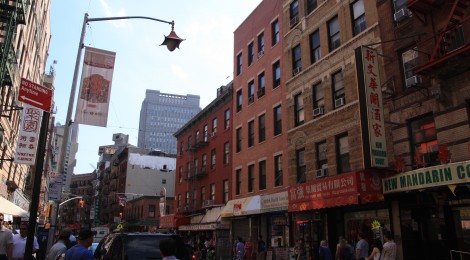
Local Shops: Immigration, Globalization, and Gentrification in New York City
Beginning in fall 2010, Philip Kasinitz and Sharon Zukin have worked with a team of more than a dozen students in the PhD Program in Sociology to trace large-scale changes in New York City by looking at small-scale changes in local shopping streets, especially the reshaping of these streets as social spaces by immigration, globalization, and gentrification. We chose three research sites in different parts of the city: Orchard Street on the Lower East Side of Manhattan; 6 blocks of Fulton Street on either side of the Nostrand Avenue subway station in Bedford-Stuyvesant, Brooklyn; and Roosevelt Avenue between 75th and 82nd Streets in Jackson Heights, Queens. Each site differs in its history, demographics, and current conditions, but each has been revitalized during the past thirty years by more than one wave of immigration. Orchard Street, moreover, has shifted from a street of mainly Jewish-owned shops selling garments and fabrics at discount prices to a center of art galleries, restaurants, and bars on a “hipster” model of gentrification. Fulton Street has made a transition from disinvestment and abandonment to the opening of discount chain stores and fast-food franchises as well as individually owned, “mom and pop” shops, many owned by Caribbean, West African, and South Asian immigrants. Roosevelt Avenue has become a center of Latino commerce, with store owners, employees, customers, and street vendors coming from Mexico, Central America, and South America.
We have carried out about twenty informal interviews with store owners and managers on both Orchard and Fulton Streets, and are in the process of contacting the same groups on Roosevelt Avenue. The students have made extensive field notes from their ethnographic observations on the street and in the restaurants and shops. We are looking at changes in the types of retail businesses in each of the streets, how the different businesses relate to local and distant customers, and how the store owners form cooperative or conflictual relations with other business owners.
We have two goals: on the one hand, we want to use the narratives of different groups of store owners to project the story of immigration, globalization, and gentrification in New York City since 1980, and on the other hand, we want to see how social spaces of “everyday diversity” are formed. So we are not looking at local shopping streets as case studies of immigrant entrepreneurialism, but as assemblages of narratives and interactions that create urban social spaces. We are coordinating our research in New York with the parallel projects of research teams in Shanghai, Tokyo, Amsterdam, Berlin, and Toronto.
Working collectively, we have created and the students have made presentations on the Local Shops project at meetings of the American Sociological Association and the Eastern Sociological Society. Phil and Sharon have made presentations at a workshop of our international research partners at Fudan University in Shanghai and the Tenement Museum in Manhattan. During the first two years, Laura Braslow coordinated the work of the research team and did additional quantitative analysis. Team members are Jacob Lederman, Sara Martucci, Samantha Saghera, Tommy Wu, and Fang Xu (Orchard Street); Benjamin Haber, Greg Narr, and Vanessa Paul (Fulton Street); Samantha Saghera also works on Roosevelt Avenue with Pilar Ortiz and Albert Novelozo.


